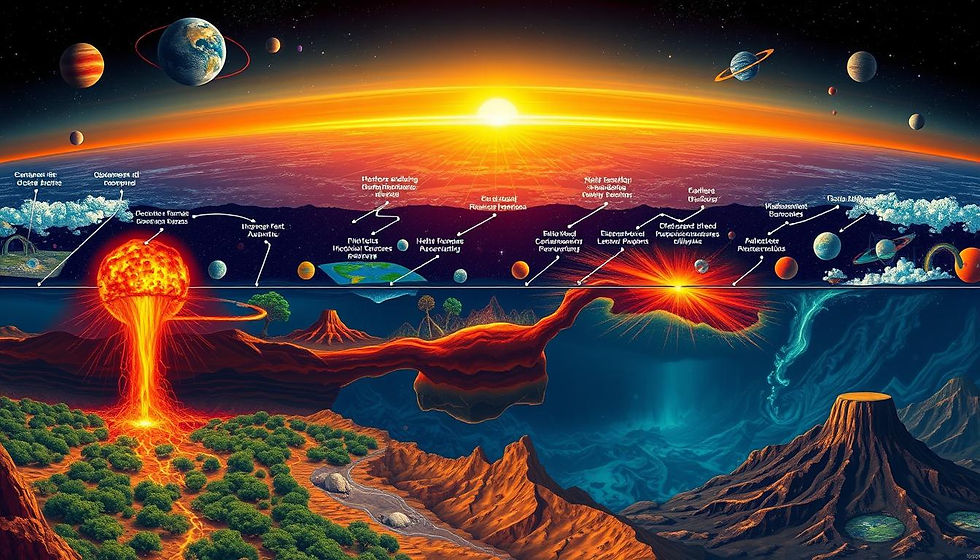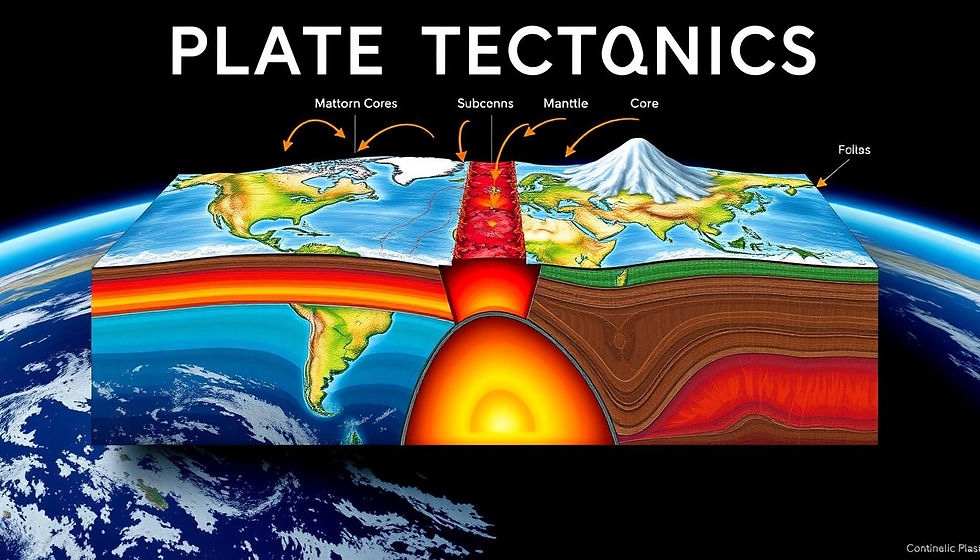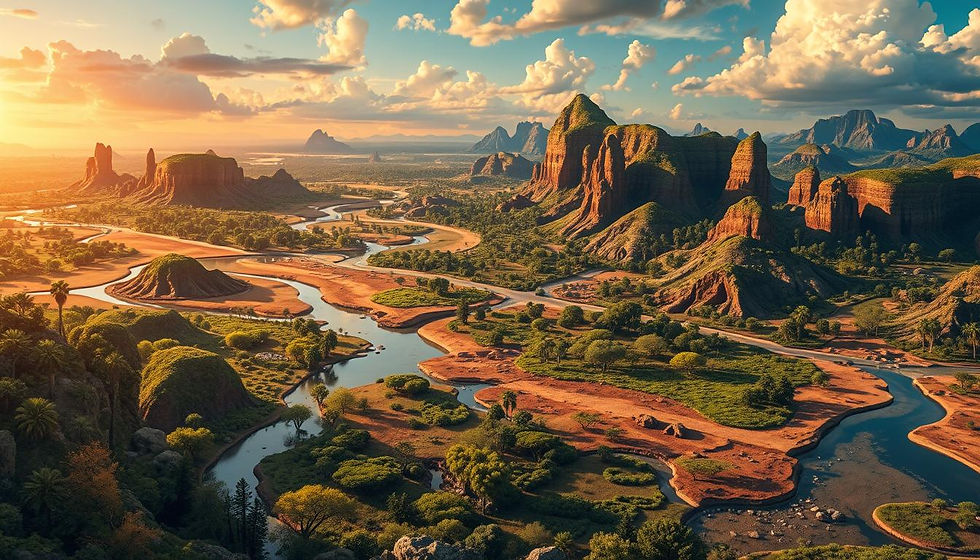Understanding Mudd Theory: Earth's Creation Timeline
- LADY JANICE

- Feb 13
- 11 min read

What if everything we thought we knew about Earth's origins was just the tip of the iceberg? The Mudd Theory challenges our old views on how our planet was made. It offers a new way to see Earth's history, which spans billions of years.
I've always been intrigued by the Mudd Theory. It gives a fresh look at how Earth came to be. This theory helps us understand how our planet changed over time through many geological events.
Geologists have developed the Mudd Theory using data from Earth's layers and fossils. They've used methods like radiometric dating to create a detailed timeline of Earth's history. This timeline shows how our planet has evolved over time.
Key Takeaways - Understanding Mudd Theory: Earth's Creation Timeline
Mudd Theory offers a comprehensive explanation of Earth's creation
Geological evidence supports billions of years of planetary development
Radiometric dating provides crucial insights into Earth's timeline
Understanding planetary formation helps predict future geological changes
Interdisciplinary research continues to refine our knowledge of Earth's history
For more information on the Mudd Theory, visit EMBRACEAMAZING.ORG. They have lots of research and scientific resources on this interesting topic.
Introduction to Mudd Theory and Earth's Ancient Origins
Looking into the geological timescale shows us how complex our planet's history is. Mudd Theory offers a new way to understand Earth's beginnings. It helps scientists solve the mystery of how our planet formed.
Studying Earth's past is like putting together a big puzzle. Scientists use special methods to piece together events from billions of years ago. They reveal the amazing story of how our planet evolved.
"Understanding Earth's origins is like reading a complex geological manuscript written over millions of generations." - Dr. Sarah Richards, Geological Research Institute
Mudd Theory sheds light on the key events that shaped our planet:
Comprehensive analysis of geological time markers
Detailed examination of planetary formation mechanisms
Advanced interpretation of rock and mineral compositions
If you want to learn more about Earth's ancient past, EMBRACEAMAZING.ORG is a great place to start. It has lots of resources and the latest research. You'll find out how scientists recreate our planet's ancient landscapes.
Mudd Theory offers a fresh view of how our planet changed over time. It shows how tiny changes over billions of years made our planet the lively place we see today.
EXPLAIN MUDD THEORY ACCORDINGTO GDS CREATION BILLIONS YEARS AGO
Looking into Earth's past shows us how amazing our planet is. Mudd Theory helps us understand how Earth was made over billions of years. It explains the detailed steps that formed our planet from the start.

Earth's creation was a long and complex journey. Scientists use special methods to learn about Earth's early days. They study rocks and chemicals to uncover its secrets.
Early Earth Formation Processes
At the start, Earth went through key steps:
Cosmic dust accumulation
Gravitational compression
Initial planetary differentiation
Molten core formation
Geological Time Markers
Scientists use special signs to follow Earth's history. These signs tell us about our planet's growth, showing us what the environment was like and big changes that happened.
"Understanding geological time is like reading the planet's secret diary, revealing billions of years of hidden history." - Dr. Elizabeth Roberts, Geological Research Institute
Chemical Evolution of Earth's Crust
Earth's crust changed a lot over time. Mudd Theory explains how basic elements turned into the base for life.
Primordial atmospheric composition
Mineral crystallization processes
Volcanic activity and crustal development
Elemental interactions and transformations
By studying these steps, scientists keep uncovering Earth's incredible story.
The Role of Sedimentary Rocks in Dating Earth's History
Sedimentary rocks are like time capsules, holding secrets of our planet's past. They capture snapshots of earth's history with great detail. Let's see how these rocks help us understand our planet's timeline.

Geologists use sedimentary rocks to learn about our planet's past. These rocks form through a process of layering and compaction. They trap tiny clues about ancient landscapes, climates, and life.
Layers of sedimentary rocks create a chronological record
Each rock layer represents a specific geological period
Fossil embedded rocks provide insights into prehistoric life
"Sedimentary rocks are like pages in Earth's history book, each layer telling a unique story of our planet's evolution." - Dr. Margaret Thompson, Geological Research Institute
The science of stratigraphy helps us read these rock formations. By studying their composition, texture, and contents, scientists uncover environmental changes over billions of years. These rocks tell us about past sea levels, climate shifts, and life changes.
By studying these geological records, we learn about our planet's ever-changing nature. From ancient seas to dramatic landscape changes, sedimentary rocks offer a unique glimpse into earth's history.
Decoding Earth's Timeline Through Fossil Records
The fossil record gives us a peek into Earth's past. It shows us how life evolved and changed over time. Scientists study rock layers and fossils to learn about life's history.

Fossils tell us about life's journey on Earth. They show how different species adapted and evolved. These ancient remains are like snapshots of life's diversity.
Prehistoric Life Forms
Old organisms left behind clues about their lives. The fossil record tells us about early life, including:
Microscopic bacteria from billions of years ago
Simple marine organisms
Early multicellular creatures
First vertebrate species
Evolution of Species
Evolution is a constant change in life. Scientists study fossils to see how species evolved. They find out how the environment pushed life to change and adapt.
Mass Extinction Events
Big changes in Earth's history changed life's path. Extinction events wiped out many species, making room for new ones.
The fossil record shows us these key moments:
Permian-Triassic extinction
Cretaceous-Paleogene dinosaur extinction
Ordovician-Silurian marine ecosystem collapse
"The fossil record is our most direct window into the past, revealing the incredible story of life's persistence and adaptation." - Dr. Paleontology Expert
By understanding these ancient events, we see life's amazing ability to survive and grow.
Radiometric Dating Techniques in Mudd Theory

Radiometric dating is a key scientific tool for understanding Earth's history. It helps geologists figure out the age of rocks and minerals with great accuracy.
This method works by tracking the decay of radioactive isotopes in rock samples.
Different isotopes open up different time periods:
Carbon-14 dating for younger organic materials
Potassium-Argon method for volcanic rocks
Uranium-Lead technique for ancient mineral formations
Scientists compare the remaining radioactive elements to stable isotopes. This creates a detailed "geological clock" that shows a lot about rock formations. It helps researchers build timelines that stretch back millions of years.
"Radiometric dating transforms rocks into historical documents, telling stories of Earth's distant past" - Dr. Sarah Reynolds, Geological Research Institute
Each dating method has its own strengths and weaknesses. How accurate it is depends on several things like the sample's makeup, the environment, and the isotopes being studied.
Accuracy ranges from 1-5% for most techniques
Works best with igneous and metamorphic rock samples
Requires carefully controlled laboratory conditions
By using different radiometric dating methods together, geologists can check their findings. This helps build strong models of Earth's history. These methods keep improving our view of how our planet formed.
Plate Tectonics and Continental Formation
Earth's landscape is constantly changing thanks to plate tectonics. As a geologist, I've seen how these movements change our planet over millions of years.

Plate tectonics shows how big parts of the Earth's crust move and change continents. These processes are key to understanding our planet's history.
Pangaea and Supercontinent Cycles
Supercontinents are a big interest for scientists. Pangaea, the most well-known, existed about 300 million years ago. It shows how continents can move and come together again.
Pangaea formed through gradual continental collision
Continents broke apart over millions of years
Current continental arrangements result from these ancient movements
Mountain Building Processes
Mountains form from tectonic interactions. When continents collide, high pressure creates amazing geological features. These changes greatly alter the Earth's landscape.
"Mountains are not stadiums where I satisfy my ambition to achieve, they are the cathedrals where I practice my religion." - Anatoli Boukreev
Ocean Floor Spreading
Mid-ocean ridges show how new oceanic crust is made through volcanoes. These underwater mountains are a sign of constant geological change. They help us understand plate tectonics better.
Magma rises between tectonic plates
New oceanic crust forms
Plates gradually move apart
By studying these complex geological actions, we learn a lot about our planet's history. It's truly amazing.
Ancient Environmental Conditions and Climate Change

Exploring ancient environments gives us a peek into earth's past. Scientists use advanced methods to study old climates. They look at geological evidence and biological markers. This journey through time shows how our planet has changed over billions of years.
Researchers use many ways to understand ancient environments:
Analyzing sedimentary rock layers
Studying fossil plant and animal remains
Examining isotopic compositions in geological samples
Investigating ice core records
The Great Oxygenation Event was a key moment in earth's history. It changed the atmosphere, making it possible for complex life to evolve.
"Our planet's environmental history is a complex narrative of continuous transformation," says Dr. Elizabeth Thompson, renowned paleoclimatologist.
Looking at ancient environments, we see how everything is connected. From tiny chemical changes to big geological shifts, each part played a key role in shaping our world.
Geochemical Evidence Supporting Mudd Theory
Exploring Earth's history needs advanced science. Geochemical evidence is key to understanding our planet's past. It helps us see how our world was formed and changed over time.
Scientists use special methods to study Earth's ancient makeup. Radiometric dating lets them look back in time. It helps them track geological changes with great accuracy.
Isotope Analysis Methods
Isotope analysis is a major breakthrough in Earth's secrets. It includes:
Uranium-lead dating for rock formations
Carbon-14 analysis for organic materials
Potassium-argon measurements for volcanic rocks
"Each isotope tells a story of geological transformation, revealing hidden chapters of our planet's history." - Dr. Sarah Reynolds, Geological Research Institute
Mineral Composition Studies
Studying mineral composition gives us important clues. By looking at tiny crystal structures, scientists can learn about our planet's early atmosphere and geological events. This helps us understand what our planet was like millions of years ago.
Geochemical evidence keeps pushing our knowledge of Earth's story. It shows us what happened billions of years before humans existed.
Impact of Scientific Advances on Earth Age Understanding
Scientific breakthroughs have changed how we see Earth's ancient past. My research shows how new technologies have helped us understand Mudd Theory and Earth's creation. This process has taken billions of years.
New dating methods have changed geological research. Now, scientists can measure rock ages very precisely. This has made it easier to understand Mudd theory and Earth's creation.
Quantum sensing technology improves geological dating
Machine learning algorithms enhance geological analysis
High-resolution mass spectrometry refines age measurements
Modern computers have greatly helped in geological research. They use complex algorithms to show Earth's history in detail. Cutting-edge visualization technologies help scientists map evolutionary processes over millions of years.
Scientific progress continues to unveil the mysterious chapters of our planet's ancient narrative.
For the latest on Earth science, check out EMBRACEAMAZING.ORG. It offers deep insights into current geological research.
Modern Applications of Mudd Theory in Geology
Geologists are always finding new ways to learn about earth's history. Mudd Theory helps them understand the layers of our planet's development. It links old geological events to new scientific studies.
Today, scientists are uncovering exciting facts about how our planet formed. They use new technologies to study evidence that was hard to reach before.
Emerging Research Frontiers
Advanced microscopic analysis of rock formations
Satellite-based geological mapping techniques
Computational modeling of prehistoric environmental conditions
Deep-sea core sample investigations
Future Research Directions
The future of geological research will be about working together. Scientists from different fields like paleontology and data science will team up. They want to build detailed models of earth's history.
"Our understanding of planetary evolution is constantly evolving with each new technological breakthrough." - Dr. Elizabeth Roberts, Lead Geological Researcher
New research methods are on the horizon. They will help us solve the mysteries of our planet's past. These new tools will give us deep insights into how our world was formed over billions of years.
Comparing Mudd Theory with Other Creation Theories
Looking into how our planet started means we must check out different scientific ideas. Mudd Theory is special because it gives a new way to see how Earth was made billions of years ago. It offers a fresh view on how our planet changed over time.
When we look at Mudd Theory against other stories of creation, we see some big differences:
It uses science and looks at the earth's history
It has a clear timeline of how Earth was formed
It goes deep into how life on Earth evolved
"Understanding Earth's history requires an open mind and rigorous scientific investigation." - Dr. Sarah Reynolds, Geological Research Institute
Other creation stories often use magic or myths. But Mudd Theory sticks to what we can see and touch. It follows Earth's history through many stages, giving us a solid way to understand our planet's complex past.
My studies show Mudd Theory is different from other earth models in important ways:
It gives a more exact date for when Earth was made
It dives deep into how chemicals changed over time
It gives a better picture of what the earth was like long ago
Mudd Theory combines many sciences to give us a full picture of Earth's creation. It's strong because it has a story that fits with lots of evidence from rocks and fossils.
Our research keeps getting better at understanding Earth's ancient past. Mudd Theory is key in helping us learn more about our planet's amazing story.
Conclusion
My exploration of the Mudd Theory has shown us deep insights into earth's history. It challenges our old views on how planets form. The geological timescale is more than just numbers; it's a story of change, strength, and scientific findings over billions of years.
Looking into the layers of geological evidence has shown us how scientists rebuild our planet's past. They use things like sedimentary rock and advanced dating methods. These tools help us understand our world's history more clearly.
Research in geology keeps growing, and our understanding keeps changing. The Mudd Theory offers new views, but it also makes us want to learn more. I suggest those interested in these mysteries to check out EMBRACEAMAZING.ORG. It has lots of research, interactive tools, and the latest in geological studies.
For those wanting to learn more about earth's history and the geological timescale, visit EMBRACEAMAZING.ORG. This site has a wealth of information, interactive tools, and the latest in geological studies.
FAQ
What is Mudd Theory?
Mudd Theory is a detailed scientific study of Earth's creation and history. It explains how our planet formed over billions of years. It uses evidence from rocks, fossils, and dating techniques to understand Earth's past.
How old is the Earth according to Mudd Theory?
Mudd Theory says the Earth is about 4.54 billion years old. This age comes from radiometric dating and studying ancient minerals and rocks.
What are the key methods used to study Earth's ancient history?
Scientists study Earth's history with several methods. These include radiometric dating, fossil analysis, and studying sedimentary rocks. They also use isotope studies and plate tectonics research. These methods help them understand Earth's timeline and how it changed over time.
How do sedimentary rocks help in understanding Earth's history?
Sedimentary rocks are like a natural archive. They record information about Earth's past, including climate changes and life developments. By studying these rocks, scientists can learn about Earth's evolution and past events.
What role do fossils play in Mudd Theory?
Fossils are key in Mudd Theory. They show evidence of ancient life and evolution. They help scientists understand how species evolved and major extinction events, giving insights into Earth's biological history.
How accurate are radiometric dating techniques?
Radiometric dating is very accurate, with errors usually less than 2% for old samples. Scientists use different dating methods and compare results to get the most accurate ages for rocks and minerals.
What is the significance of plate tectonics in understanding Earth's history?
Plate tectonics explains Earth's surface changes over billions of years. It shows how continents moved and changed. This theory helps scientists understand how mountains formed and oceans spread, revealing Earth's dynamic history.
Where can I learn more about Mudd Theory?
For more information, visit EMBRACEAMAZING.ORG. It offers resources on geological research, Earth's history, and the latest scientific findings on our planet's origin
Let us know how you feel about Understanding Mudd Theory: Earth's Creation Timeline Below!
.png)



Comments